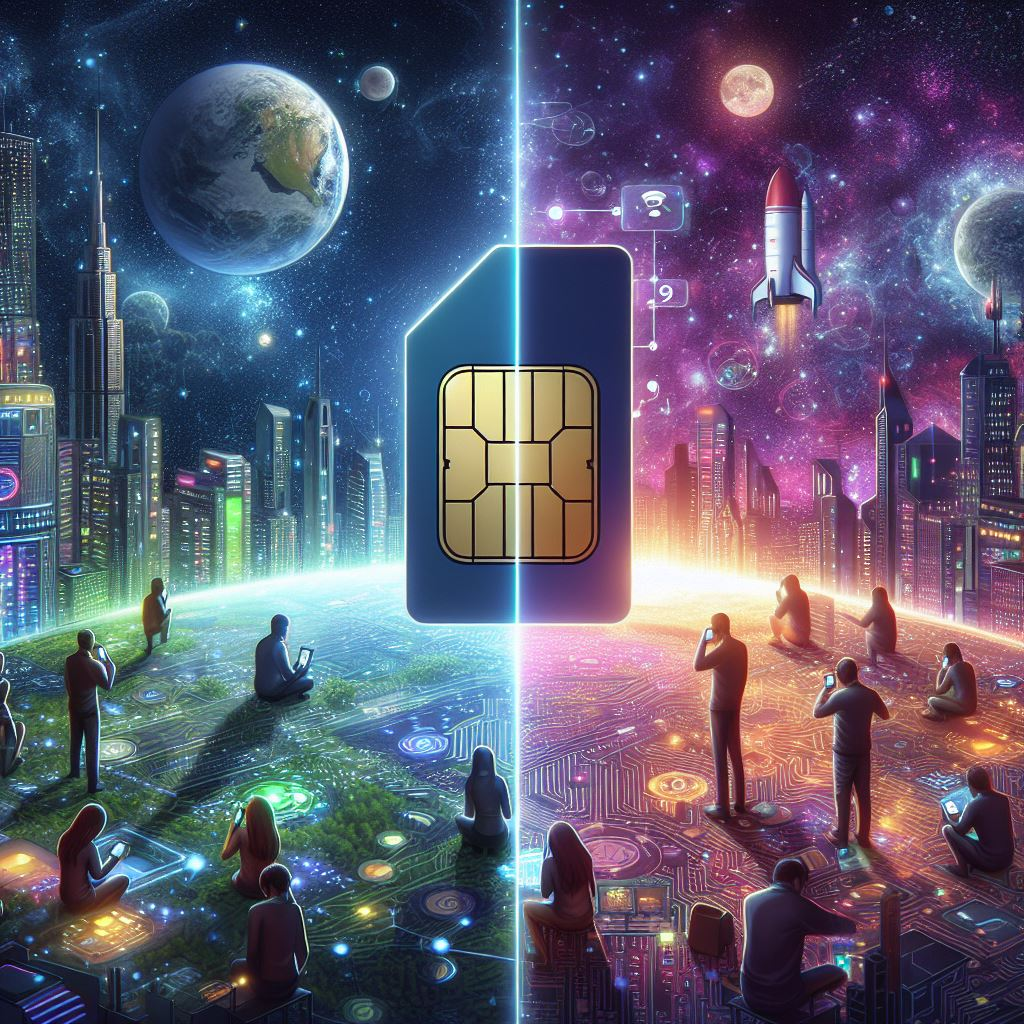Calling with Data Only eSIM
Published by
Jan 17 2024

The Advantages of Using eSIM for Data-Only Phone Calls

The Seamless Experience of Data-Only eSIMs.
The rise of eSIM technology has opened up new possibilities for phone calls, specifically for data-only usage. Calling with a data-only eSIM offers various advantages that make it an attractive option for users. First and foremost, it eliminates the need for a physical SIM card, as the eSIM is integrated into the device itself. This means no more worrying about losing or damaging SIM cards. Additionally, with a data-only eSIM, users can make phone calls using their mobile data, without the need for a traditional voice plan.
One of the key benefits of using a data-only eSIM for making phone calls, is the flexibility it provides. Users can receive calls on their phone number, even without an active voice plan. This is made possible by routing voice calls over the cellular data network. This not only ensures that users stay connected at all times but also allows for seamless transition between calls made over Wi-Fi and calls made on the go.
Exploring the Benefits of Data-Only eSIM Plans
Data-only eSIM plans offer a range of benefits for those looking for flexible and convenient ways to stay connected. With traditional data plans, users often need to switch out physical SIM cards when traveling or using a cellular plan for multiple devices. However, with eSIM data plans, this hassle is eliminated as users can have multiple eSIM profiles stored on their device.
One of the significant advantages of data-only eSIM plans is the ability to make phone calls through Voice over Internet Protocol (VoIP) services. This allows users to make phone calls without the need for a traditional physical SIM card. Providers like Google Voice offer eSIM support, enabling users to have phone numbers associated with their eSIM data plans. This means that even with a data-only eSIM plan, voice and video calls can still be made, ensuring that users can stay connected with their contacts regardless of their internet connection.
In conclusion, data-only eSIM plans offer the flexibility of having multiple eSIM profiles on a single device, eliminating the need to switch out physical SIM cards. Additionally, these plans provide the convenience of making and receiving calls through VoIP services, maintaining voice and video communication even without a physical SIM card. With these benefits, data-only eSIM plans are an excellent choice for those looking for efficient and versatile connectivity options.
How eSIM Technology Enhances Mobile Data Connectivity

The Inner Workings of Voice Calls Through Data-Only eSIM.
eSIM technology is revolutionizing mobile data connectivity by offering users a more convenient and versatile way of staying connected. Unlike traditional SIM cards that require physical swapping, eSIMs are embedded within the device, allowing users to switch between different data plans without the hassle of physically changing SIM cards.
One of the key advantages of eSIM technology is its ability to enable video calls and Wi-Fi calling seamlessly. With an eSIM, users can make high-quality video calls using cellular data or easily switch to Wi-Fi calling when connected to a stable network. This flexibility ensures uninterrupted communication, regardless of the availability of traditional voice calls or the strength of the cellular network. Furthermore, the embedded eSIM allows users to assign a primary phone number to their device, eliminating the need for multiple SIM cards and simplifying the management of incoming calls.
In addition to video calls and Wi-Fi calling, eSIM technology also enhances mobile data connectivity by providing access to internet-based calling apps. These apps leverage the device’s eSIM and utilize the internet connection to make voice calls, bypassing the need for traditional phone lines. This feature enables users to make cost-effective international calls and stay connected with friends, family, and colleagues globally.
The Role of eSIM in Ensuring Stable Internet Connection for Calls
eSIM technology plays a crucial role in ensuring a stable internet connection for phone calls. Unlike traditional SIM cards, which are limited to voice and text services, eSIMs allow users to make phone calls over a data-only connection. This innovative approach enables seamless communication through various internet-enabled platforms without the need for physical SIM cards.
One of the significant advantages of using eSIMs for calls is the flexibility it offers in terms of data roaming. With a data-only eSIM, users can stay connected wherever they go, eliminating the need for purchasing local SIM cards or relying on Wi-Fi hotspots. This means that international travelers can easily make and receive calls with the same convenience as local calls, without incurring hefty roaming charges. eSIMs also provide the convenience of call forwarding, allowing users to redirect calls to their preferred devices or numbers, making it even more convenient to stay connected while on the move.
In addition to stability and convenience, eSIMs offer the benefit of unlimited data for calls. With traditional SIM cards, data usage for phone calls can quickly deplete the allocated data. However, with eSIMs, users can make free calls and send messages using a data connection without worrying about exhausting their data limits. This opens up new possibilities for communication, as users can make phone calls and send text messages using a variety of apps that rely on internet protocols, all while enjoying unlimited data.
Understanding the Difference Between Traditional SIM Cards and eSIMs for Data Usage

Traditional Calls vs. Data-Only eSIM Voice Connectivity.
Traditional SIM cards and eSIMs are two distinct technologies used for data usage on mobile devices. While both provide internet connectivity, they differ in terms of physicality, flexibility, and the way they are managed by service providers.
One of the primary differences between traditional SIM cards and eSIMs is the physicality of the cards. Traditional SIM cards are small, removable chips that need to be physically inserted into a compatible device. On the other hand, eSIMs are virtual SIM cards that are built into the device itself, eliminating the need for a physical card. This makes eSIMs more convenient as users do not have to worry about losing or damaging their physical SIM cards.
Another notable difference is the flexibility offered by eSIMs. With traditional SIM cards, users are restricted to using the services provided by the card they have inserted. However, eSIMs offer the flexibility of switching between different service providers and plans without the need to physically swap out SIM cards. This is particularly advantageous for travelers who can easily switch to a local network or a data-only eSIM plan while retaining their voice communication with their primary service provider.
In terms of internet connectivity and call quality, both traditional SIM cards and eSIMs utilize similar technologies like Wi-Fi and cellular networks. However, eSIMs can enhance the internet connectivity experience, especially when connected to a stable Wi-Fi network. Additionally, eSIMs can help reduce roaming charges when making international calls, as users can simply switch to a local eSIM plan instead of relying on expensive roaming services. This not only saves money but also provides a more convenient method of communication while traveling abroad.
In conclusion, while traditional SIM cards and eSIMs both provide data usage and voice communication services, they differ in physicality, flexibility, and their impact on internet connectivity. eSIMs, as virtual SIM cards, offer the advantage of convenience and flexibility, allowing users to switch between different service providers and plans seamlessly. They also contribute to improved call quality, reduced roaming charges, and a more reliable internet connection, particularly when connected to Wi-Fi networks.
Making International Calls with eSIM: Cost-Effective and Convenient
International calls have become an essential part of our daily communication, and with the advent of eSIM technology, making these calls has become more cost-effective and convenient than ever before. eSIMs allow users to have multiple profiles on their primary line, which means that they can switch between different cellular plans seamlessly. This flexibility is particularly useful for travelers who frequently visit different countries, as they no longer need to worry about changing their physical SIM card every time they cross borders. Instead, eSIMs allow them to stay connected wherever they go by simply scanning a QR code provided by their device manufacturer.
In addition to being cost-effective, using eSIMs for international calls also offers convenience. With eSIMs, users can make and receive calls over Wi-Fi, eliminating the need for a traditional SIM card or relying solely on a cellular network. This feature not only reduces the risk of incurring hefty roaming charges but also ensures a stable internet connection, even in areas with weak or no cellular coverage. Furthermore, the availability and pricing of data plans can vary depending on the country and service provider, so having the option to easily switch between different, cellular data plans through eSIM technology allows users to choose the most suitable and affordable option for their international calling needs.
How Internet Protocol (IP) Enables Voice Calls via eSIM

Initiating Calls Using Data-Only eSIM Technology.
The use of Internet Protocol (IP) is the key to enabling voice calls through eSIM technology. With IP, voice calls can be transmitted as data packets over the internet, allowing users to make calls using their eSIM cards. This technology eliminates the need for a traditional SIM card and provides a more versatile and efficient method for making calls.
One of the primary advantages of using IP for voice calls via eSIM is the ability to have multiple numbers connected to a single device. With eSIM, users can have multiple numbers associated with their device, allowing them to make and receive calls using different area codes. This is particularly useful for frequent travelers or individuals who have business contacts in different regions.
Additionally, eSIM plans often offer the advantage of lower costs for making international calls compared to traditional voice plans, as they utilize internet connectivity rather than traditional phone networks. This means that users can make calls to other eSIM users or even regular phone numbers without incurring extra costs.

Connecting Through Data: Unveiling the Possibilities of Calls with Data-Only eSIM.
What is eSIM technology?
eSIM, short for embedded SIM, is a digital alternative to traditional physical SIM cards. It is embedded directly into a device, allowing for easy remote activation and storage of multiple SIM profiles.
How does eSIM enable voice calls?
eSIM technology supports voice calls by utilizing internet protocol (IP) to transmit voice data over the internet. This enables voice calls to be made and received through data-only eSIM plans.
What are the advantages of using eSIM for data-only phone calls?
Using eSIM for data-only phone calls offers several advantages, including cost-effectiveness, convenience, and the ability to have multiple phone numbers on a single device.
How does eSIM technology enhance mobile data connectivity?
eSIM technology enhances mobile data connectivity by enabling seamless switching between different mobile network operators, ensuring better coverage and connectivity in various locations.
What is the role of eSIM in ensuring a stable internet connection for calls?
eSIM plays a crucial role in ensuring a stable internet connection for calls by allowing devices to automatically connect to the strongest available network, minimizing call drops and disruptions.
How is data usage different between traditional SIM cards and eSIMs?
Traditional SIM cards physically store data, while eSIMs store data digitally. This means that eSIMs can be remotely provisioned and activated, making them more flexible and convenient for users.
Can eSIM be used for making international calls?
Yes, eSIM can be used for making international calls. It offers cost-effective and convenient options for users, eliminating the need for physical SIM card swapping or expensive international roaming fees.
Is using internet protocol (IP) secure for voice calls via eSIM?
Yes, using internet protocol (IP) for voice calls via eSIM is secure. Voice data transmitted over IP networks is encrypted, ensuring privacy and maintaining the security of the communication.

